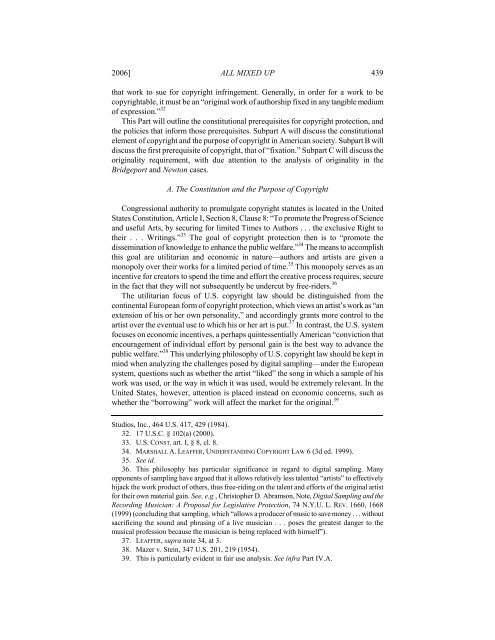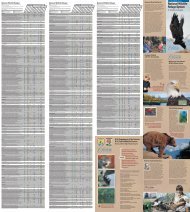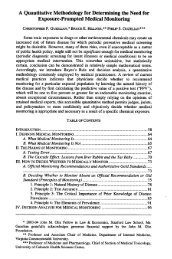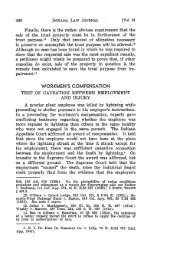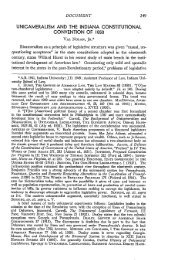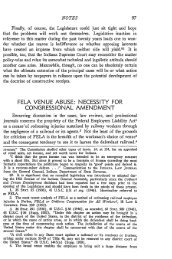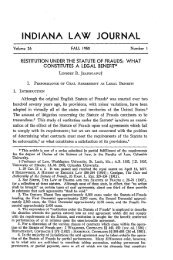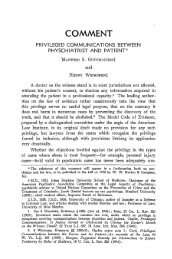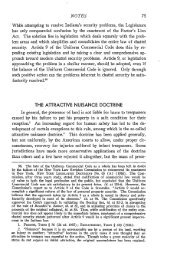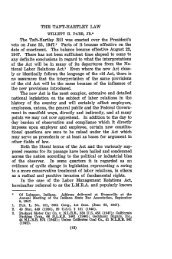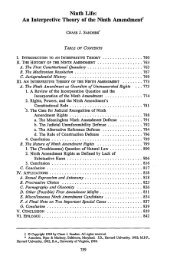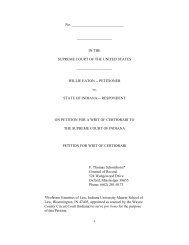Bridgeport Music v. Dimension Films - Indiana University School of ...
Bridgeport Music v. Dimension Films - Indiana University School of ...
Bridgeport Music v. Dimension Films - Indiana University School of ...
You also want an ePaper? Increase the reach of your titles
YUMPU automatically turns print PDFs into web optimized ePapers that Google loves.
2006] ALL MIXED UP 439<br />
that work to sue for copyright infringement. Generally, in order for a work to be<br />
copyrightable, it must be an “original work <strong>of</strong> authorship fixed in any tangible medium<br />
<strong>of</strong> expression.” 32<br />
This Part will outline the constitutional prerequisites for copyright protection, and<br />
the policies that inform those prerequisites. Subpart A will discuss the constitutional<br />
element <strong>of</strong> copyright and the purpose <strong>of</strong> copyright in American society. Subpart B will<br />
discuss the first prerequisite <strong>of</strong> copyright, that <strong>of</strong> “fixation.” Subpart C will discuss the<br />
originality requirement, with due attention to the analysis <strong>of</strong> originality in the<br />
<strong>Bridgeport</strong> and Newton cases.<br />
A. The Constitution and the Purpose <strong>of</strong> Copyright<br />
Congressional authority to promulgate copyright statutes is located in the United<br />
States Constitution, Article I, Section 8, Clause 8: “To promote the Progress <strong>of</strong> Science<br />
and useful Arts, by securing for limited Times to Authors . . . the exclusive Right to<br />
their . . . Writings.” 33 The goal <strong>of</strong> copyright protection then is to “promote the<br />
dissemination <strong>of</strong> knowledge to enhance the public welfare.” 34 The means to accomplish<br />
this goal are utilitarian and economic in nature—authors and artists are given a<br />
monopoly over their works for a limited period <strong>of</strong> time. 35 This monopoly serves as an<br />
incentive for creators to spend the time and effort the creative process requires, secure<br />
in the fact that they will not subsequently be undercut by free-riders. 36<br />
The utilitarian focus <strong>of</strong> U.S. copyright law should be distinguished from the<br />
continental European form <strong>of</strong> copyright protection, which views an artist’s work as “an<br />
extension <strong>of</strong> his or her own personality,” and accordingly grants more control to the<br />
artist over the eventual use to which his or her art is put. 37 In contrast, the U.S. system<br />
focuses on economic incentives, a perhaps quintessentially American “conviction that<br />
encouragement <strong>of</strong> individual effort by personal gain is the best way to advance the<br />
public welfare.” 38 This underlying philosophy <strong>of</strong> U.S. copyright law should be kept in<br />
mind when analyzing the challenges posed by digital sampling—under the European<br />
system, questions such as whether the artist “liked” the song in which a sample <strong>of</strong> his<br />
work was used, or the way in which it was used, would be extremely relevant. In the<br />
United States, however, attention is placed instead on economic concerns, such as<br />
whether the “borrowing” work will affect the market for the original. 39<br />
Studios, Inc., 464 U.S. 417, 429 (1984).<br />
32. 17 U.S.C. § 102(a) (2000).<br />
33. U.S. CONST. art. I, § 8, cl. 8.<br />
34. MARSHALL A. LEAFFER, UNDERSTANDING COPYRIGHT LAW 6 (3d ed. 1999).<br />
35. See id.<br />
36. This philosophy has particular significance in regard to digital sampling. Many<br />
opponents <strong>of</strong> sampling have argued that it allows relatively less talented “artists” to effectively<br />
hijack the work product <strong>of</strong> others, thus free-riding on the talent and efforts <strong>of</strong> the original artist<br />
for their own material gain. See, e.g., Christopher D. Abramson, Note, Digital Sampling and the<br />
Recording <strong>Music</strong>ian: A Proposal for Legislative Protection, 74 N.Y.U. L. REV. 1660, 1668<br />
(1999) (concluding that sampling, which “allows a producer <strong>of</strong> music to save money . . . without<br />
sacrificing the sound and phrasing <strong>of</strong> a live musician . . . poses the greatest danger to the<br />
musical pr<strong>of</strong>ession because the musician is being replaced with himself”).<br />
37. LEAFFER, supra note 34, at 3.<br />
38. Mazer v. Stein, 347 U.S. 201, 219 (1954).<br />
39. This is particularly evident in fair use analysis. See infra Part IV.A.


